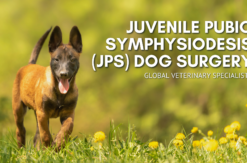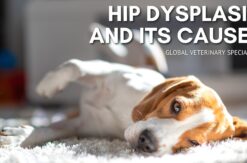Hip dysplasia (HD) is characterized by abnormal laxity of the hip joint, in which the ball and socket do not fit correctly, resulting in irregular wear of the joint surfaces. The condition leads to inflammation, pain, and lameness and may ultimately necessitate surgical intervention.
The cause of hip dysplasia is multifactorial. That means several factors can contribute to its development, with the single most significant reason believed to be genetics. Extensive research will continue on the canine genome to identify the exact hereditary code that is abnormal. Additional factors that can influence its development include diet, hormones, and the environment.
Although middle to large breed dogs – especially those popular in the United States – are more prone to hip dysplasia, its development may also affect smaller canines, including mixed breeds and even felines. Animals can present with mild, moderate, or severe cases of hip dysplasia.
Symptoms of Canine Hip Dysplasia
While some dogs can begin to show signs of HD as early as six months of age, most exhibit symptoms by one year of age. Before starting to progress gradually, symptoms are often subtle, although this may vary depending on the severity and any underlying conditions. Common symptoms your dog may exhibit include:
- Limping
- Decreased activity
- A “bunny hop” gait
- Difficulty rising after rest
- Hesitance to jump or climb stairs
- Premature tiring, especially during exercise
- Weight shifting from one or both hind feet
- Slightly arched back, resulting from weight shifting
Over time, primarily in situations where hip dysplasia is left untreated, secondary osteoarthritis (OA) can develop. In secondary osteoarthritis, the inflamed tissues surrounding the abnormal joint may thicken with scar tissue, further impacting the dog’s quality of life. Early treatment by a veterinary surgeon is essential.
Schedule an Appointment with a Veterinary Surgeon
Global Veterinary Specialists recognize that dogs and cats encounter orthopedic injuries, disabling difficulties, and diseases that can impact their quality of life. Each GVS surgeon has more than twenty years of experience treating complex problems that may arise in your pets.
We are teachers, mentors, inventors, clinical researchers, and veterinary surgeons driven to achieve excellence for every animal we see. Please contact us today to learn how we treat hip dysplasia and restore your pet’s quality of life.



